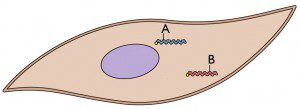

If we take 10,000 particles of our virus stock and infect 1,000,000 cells, we are adding just one infectious particle. Therefore a correct answer to the question is one plaque. But would you be wrong if you answered 100 plaques? That would depend on how you justified your answer.
To understand why 100 plaques could be correct, we need to do some math, and calculate the number of virus particles that each cell receives. If we add 10,000 particles to 1,000,000 cells, the MOI is 0.01. At that MOI, 0.01% of the cells will receive more than one virus particle. In a culture of 1 million cells, 100 cells will receive at least two virus particles and could, in theory, become productively infected. Let’s explore why.
The linear nature of the dose-response curve indicates that a single virion is capable of initiating an infection. However, the high particle-to-pfu ratio of many viruses shows that not all virions are successful. A high particle-to-pfu ratio is sometimes caused by the presence of noninfectious particles with genomes that harbor lethal mutations.
To simplify this problem, let’s assume that among the 10,000 noninfectious particles in our sample, half of them have a mutation in gene A and half have a mutation in gene B. This scenario is illustrated in the figure, which shows a cell infected with two viruses (only the viral genomes are shown). Both mutations are lethal – cells infected with either viral mutant do not produce new virus particles. However, when a cell is infected with both virus mutant A and virus mutant B, complementation of the defects might occur. The virus with mutant gene A produces a fully functional gene B product; and the virus with mutant gene B produces a fully functional gene A product. The result is that the infected cell contains functional versions of proteins A and B, and viral replication can occur. It’s also possible that the two viral genomes might undergo recombination, producing a new genome that does not contain any lethal mutations. Either mechanism could explain why we might expect to observe up to 100 plaques in this experiment.
The reality is that the 10,000 noninfectious virus particles in our stock likely have mutations in many genes, not just two. Therefore the probability that complementation or recombination can correct the defects is remote. This is the reason why we are likely to observe just one plaque in our experiment.
